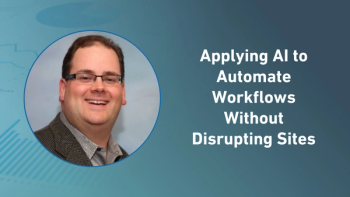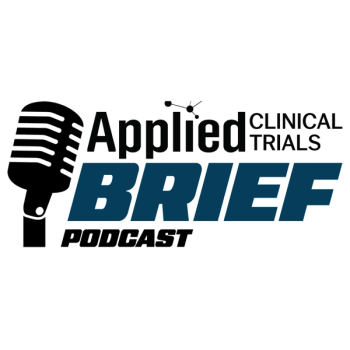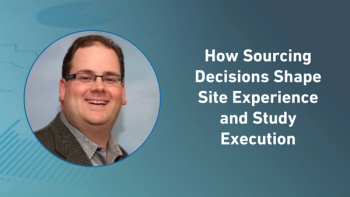Summary
AI adoption in clinical operations is accelerating, with growing optimism about its potential to cut costs, reduce manual workloads, and improve study feasibility modeling. By consolidating protocol, site, and enrollment data, AI can streamline planning, support sites proactively, and enhance decision-making. Regulatory oversight will require human review to ensure model accuracy, while unified data access can democratize insights for sponsors, sites, and analysts. Ultimately, AI’s value lies in shifting human effort toward high-impact scientific and strategic tasks, enabling faster, more informed research execution.
As artificial intelligence (AI) continues to reshape healthcare, clinical research is approaching a turning point. In this exclusive Q&A, Rohit Nambisan, CEO of Lokavant, and Jonathan Crowther, head of predictive analytics, Pfizer, discuss the current state of AI integration across clinical operations. From feasibility modeling and regulatory alignment to data democratization and workflow automation, Nambisan and Crowther highlight the opportunities and challenges being faced by sponsors, sites, and regulators as AI adoption accelerates.
ACT: Where do you think the clinical research industry as a whole currently stands with AI integration? Are you seeing any hesitancy, optimism, etc.?
Crowther: From an industry perspective, there's a huge amount of hope. It's the first time pharma has actually been able to be on the forefront of adopting new technologies. What's great is we're seeing a number of sponsor companies out there starting to spin up their own teams. If you look on LinkedIn, the number of roles that are opening up for AI strategists—for developers, for prompt engineers—is really fantastic. I think there's a lot of hope in the next couple of years, and hopefully next couple of decades of pharma using AI.
Nambisan: I would add to that that there is a significant amount of optimism. I think we are an industry that, for one reason or another, has been plagued by high costs and lots of laborious, time-consuming tasks that I feel a lot of the folks we work with believe that there's an opportunity to cut down on the costs and some of the inefficiencies leveraging AI approaches. I think there's a lot of optimism. At the same time, I think there's some concerns. Obviously, any model is fueled by data, and more data generally leads to better models. If OpenAI has taught us anything, it’s about how proprietary data is valuable. Individual pharma companies want to hold on to that value, which is at odds for generating the most optimal models.
ACT: How can AI be leveraged to model study feasibility? What challenges can this solve for clinical operations professionals if used correctly?
Nambisan: In the study feasibility phase, and then consequently, the site feasibility phase, feasibility teams want to take the scientific plan as identified by a protocol and figure out how to match that with the realities of the real world. In that process, there's a lot of time consuming, laborious work to look at similar protocols, similar studies, understand the enrollment rates, which sites were used, protocol complexity and the assessments we're doing compared to those competitors, etc. In that space, I think there's a lot of opportunity for AI to bring all of that together.
Crowther: The other piece that I think is quite important is this is a whole end-to-end value chain, so once you get to that modeling part and planning, and then the iterative, incremental improvements on the modeling and then expectation and setting with the study teams, we can then take out even more laborious work when we talk about doing surveys from sites, when we talk about analyzing data that we're getting back from sites, and making it more contextual for the study teams to make sense.
What I think is important from a sponsor side is that we’re actually able to use this data, AI, and models to actually support the site, so we can go back to sites and say, “We think there's going to be these problems with you, or here's the reason why we think there's a problem with this site and within our study.”
ACT: With the industry being so highly regulated, what are some actions being taken to ensure the accuracy of these AI models and the historical data being used to create them?
Crowther: If you talk to regulators, they're generating their own AI models to review the submissions from pharma. Pharma is then generating AI models to generate submissions to regulators, so I think there's going to be a place in the middle where human-in-the-loop is going to be essential. If we look at all tools and all models that we have for regulatory purposes, we're always going to have human in the loop. This isn't about getting rid of people. It's more about, how do we actually augment the work? From my view, I think over the next two or three years, the key piece is going to be the models will generate data. Someone is going to be able to—as a human—come in and actually review the data with a critical eye, experience, and expertise in the area, to say, “Okay, this is right, or this is not right.”
ACT: Looking forward, what excites you most about the potential of AI in clinical research?
Nambisan: Having worked in the sponsor side in two stints and then worked in the vendor side, working across a number of sponsors and contract research organizations, inclusive of my experience at Lokavant, there's a lot of manual work in regulated spaces, and people do things the way they do them just because it was done before, and there's risk to changing process. I think the opportunity here with AI is to reduce a lot of that manual work such as data crunching, so that human expertise is focused on the areas that matter most; the science, the construction of the right endpoints, and the assessment of the statistical plan from an expert perspective.
Crowther: The other piece that I like is that we're lowering the access for clinicians, for study team members, and for analysts to actually take a bigger role within their company such as a sponsor, a site, or an institution. I think that they're going to be able to do more with data for the patients, and be able to provide more information. For me, lowering the barrier to entry for people like that is going to really help accelerate things, because some of the best ideas are going to come to the top.





